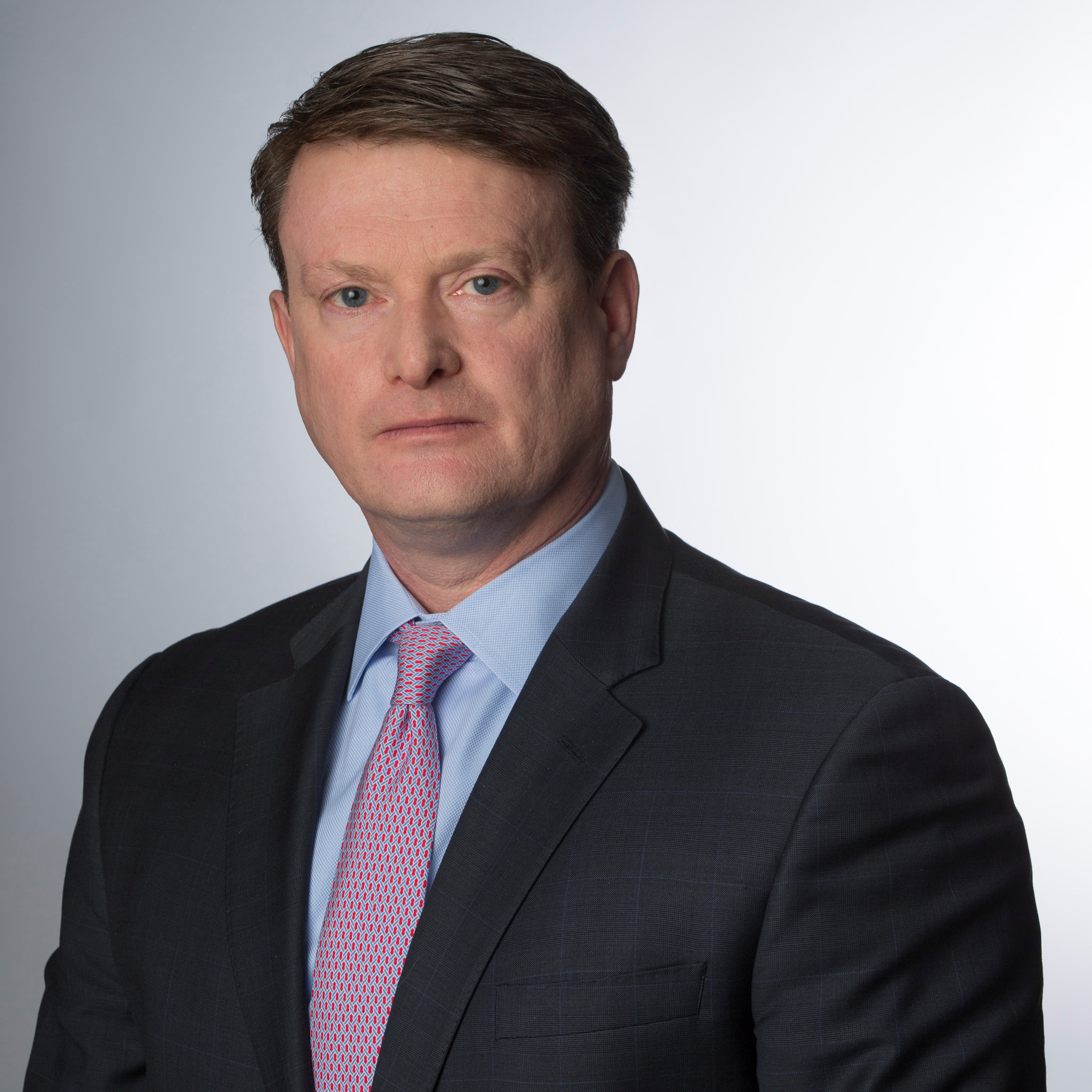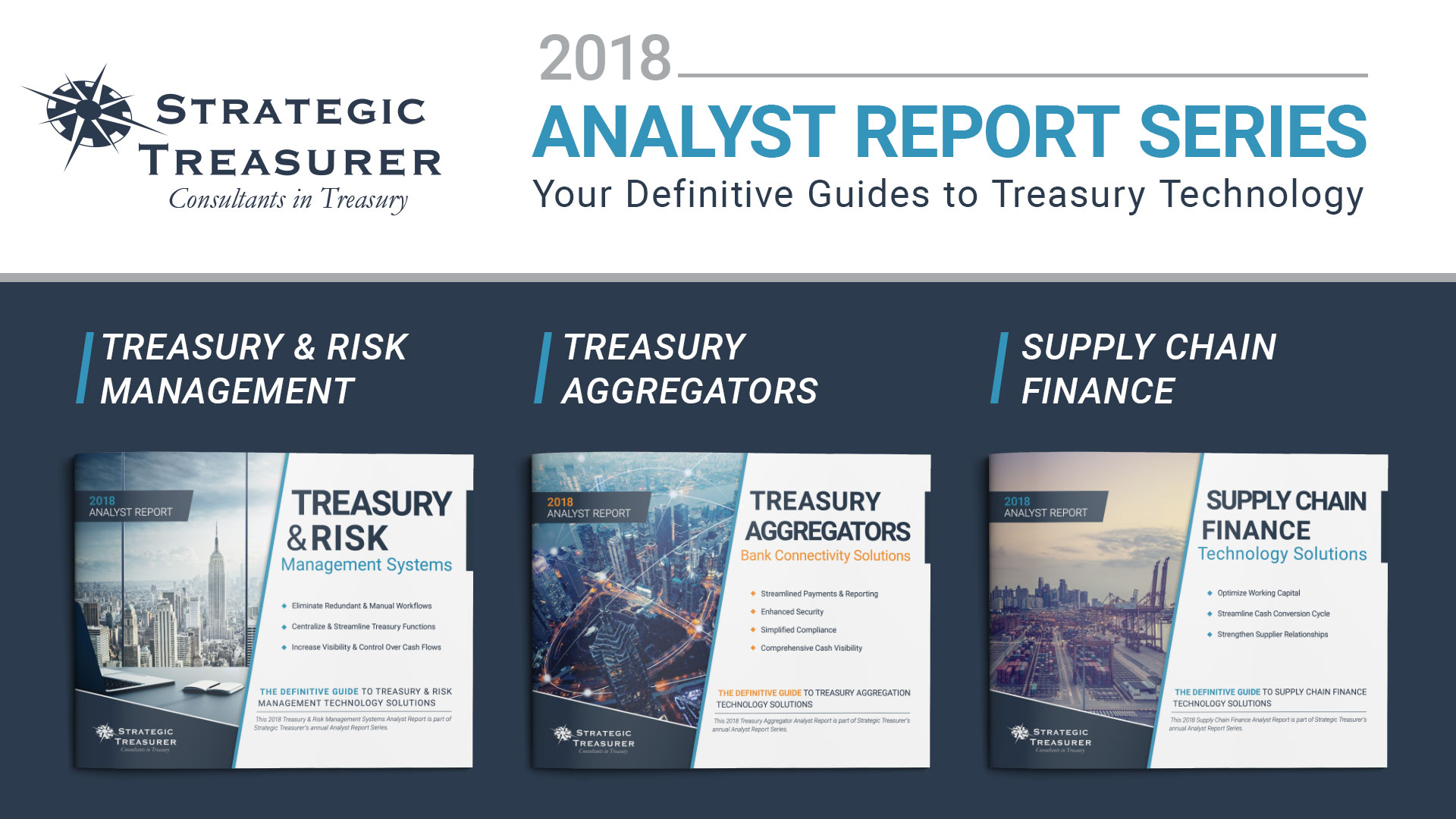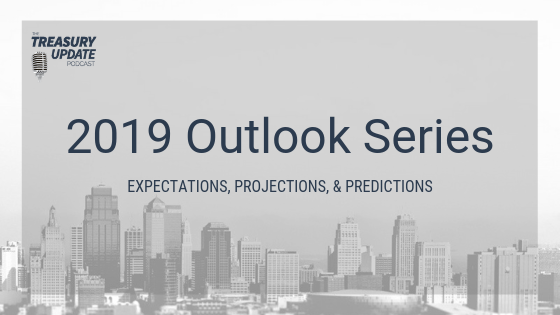
Episode 40
2019 Outlook:
Q2 Corporate Investment Outlook
2019 Outlook Series
The Treasury Update Podcast kicks-off the 2019 Outlook series featuring interviews with treasury experts about their expectations, projections, and predictions for the year ahead.
Q2 Corporate Investment Outlook
On this episode of the 2019 Outlook series, Craig Jeffery sits down with Executive Director Bob Leggett and Senior Portfolio Manager Mike Cha of Morgan Stanley to discuss the 2019 Q2 corporate investment outlook. They take a deeper look at the major shifts in short-term investing, the use of various instruments, and a number of macro shifts continuing to take place this year and beyond. Listen in to the discussion.
Host:
Speaker:
Craig Jeffery, Strategic Treasurer


Bob Leggett, Executive Director


Mike Cha, Senior Portfolio Manager


Episode Transcription - Q2 Corporate Investment Outlook (Morgan Stanley)
Craig Jeffery: Welcome to The Treasury Update Podcast. This is Craig Jeffery, and our session today is the 2019 second quarter Corporate Investment Outlook. I’m here with two gentlemen from Morgan Stanley, Bob Leggett and Michael Cha. Let me give a quick statistical summary of Morgan Stanley for the few of you who may not know. Morgan Stanley is a global financial services firm. They cover investment banking, security management, wealth management and investment management services. Their clients are corporations, governments, financial institutions and individuals. They have offices in more than 40 countries and have over 55,000 employees. And, their assets under management exceed $470 Billion. Welcome to the podcast Bob and Michael.
Bob Leggett: Thank you.
Mike Cha: Thank you.
Craig Jeffery: Bob is the Executive Director of Morgan Stanley Investment Management. He is a liquidity strategist for their global liquidity business. He has over 25 years industry experience and joined Morgan Stanley in 2015. Michael Cha is the Senior Portfolio Manager. He is part of Morgan Stanley’s Global Liquidity Team. He also has over 25 years of industry experience and joined Morgan Stanley back in 2008. But let’s begin by taking a look back over the last couple of years and through the first quarter of 2019. We have seen several major shifts in short term investing over this time, and the use of different instruments this is, been brought about in part or a reflection of some regulation changes. We’ve seen money flowing into and out of different instrument types due to some different activity on the ground if you will. What do you see as the primary causes for the changes that were out and in and different instrument groups in 2018 and even in the beginning of 2019?
Bob Leggett: Thanks, Craig. I think there’s really three themes that capture the asset movement. The first one is, thinking back to 2018, was the environment. So you had an environment where volatility was increasing, particularly in the latter half of the year. It led to poor performance for fixed income and equity strategies. And, you saw cash, if not the best, then, one of the best performing asset classes last year. So, I think the fact that you had more market volatility led to stronger flows into cash investments and, particularly, money market funds. I would say the second theme was the deposit beta environment. On the banking side you had slower deposit growth, which was driven by broader economic concerns, and a fed that was starting to reduce the size of its balance sheet, which in theory slows money supply growth and ultimately deposit creation.
Bob Leggett: You have a yield curve, which had been flattening, which puts pressures on Net Interest Margins. And, in a flatter yield curve environment banks are looking to protect their NIMS and are generally going to be less inclined to pass through rate increases to their deposits. Now, compare and contrast that to the money market funds, and there you saw funds yields were broadly keeping pace with rising short term interest rates. So effectively the rates are being passed through almost immediately, and it’s leading investors to evaluate, I think, the trade-off between funds and deposits. I would say in many cases investors found that they were able to invest in a higher quality portfolio (i.e. Government Money Market funds vs Deposits) and earn higher yield as well.
Bob Leggett: The last thing that we saw in 2018 was a resurgence of demand for what we call here at Morgan Stanley Conservative Credit Strategies. Conservative Credit it to us is, it’s being packaged in a number of different product wrappers, including Prime Money Market Funds, Conservative Ultra Short Duration Bond Funds, Private Placements, and Separately Managed Accounts. So, you saw in 2018 probably a little bit more than $100 Billion come back into Prime Institutional and Prime Retail Funds. But, if you looked at that number just in isolation, I think that underestimates the demand, because you had significant growth in Conservative Ultra Short Duration Bond Funds, probably somewhere in the neighborhood of $50 Billion. And just to be clear, we define Conservative Ultra Short Bond Funds as funds that really limit their investments to primarily Money Market Eligible Securities, limit their investments to Investment Grade only, and have generally shorter Weighted Average Maturities, let’s call it, three months, and Weighted Average lives approximately six months or less.
Bob Leggett: There was a lot of demand in that category as well. Just thinking about prime, I would say, investors have come back into the space, because they have seen limited NAV movement since reform. I think they’ve recognized that liquidity in the products has been consistently high, more than the 30% prescribed liquidity, which is required. The industry scale has returned, so if you look back to the fourth quarter 2016, there was probably five funds that were over $5 Billion. That number probably closer to 13 to 14 today. And lastly, I think investors have recognized that by moving into Prime and out of other strategies including Government Money Market Funds, there is real yield pick-up. You’re able to pick up somewhere between 20 and 30 basis points of extra yield and still satisfy primary objectives that liquidity investors have, which is principle preservation and liquidity.
Craig Jeffery: What was that gap back in 2016 or a year prior, prior to the flow back in?
Bob Leggett: I think that gap was probably closer [to] 10 to 15 basis points.
Mike Cha: Now, I was going to say that the historical average on spread between private and Government Money Market Funds over a long period of time, I know I can be compressed [and] it can widen, but it’s probably about 20 basis points.
Craig Jeffery: Okay, so you see it moving back towards the historical norms and, therefore, monies flowing back in as part of that?
Mike Cha: That’s kind of where we are right now. We are at about 20 basis points of yield pick up between Prime and Government Money Market Funds. I think the most recent developments in the market place that Bob alluded to and something that we will talk about shortly, as far as some of the macro shifts that we’ve seen recently, may actually bode to setting up a scenarios where those spreads compress. When you have a situation like that, the big question for users of Money Market Funds, as well as managers alike, is ‘What will be the behavior of the client base if that spread does start to compress?’ One of the things that I think is clear [is that] there are some clients that will require some self-imposed spread between the Government Money Market Fund and a Prime Money Market Fund, but, I think there will be a big swath of investors that are comfortable with the Prime Money Market Fund as an asset class and as a product type. And, if they can get a decent pick up, maybe ten basis points, they are still going to remain in the fund.
Craig Jeffery: Thanks for that summary of the key reasons money is flowing back into some of these other fund types, like Prime Funds. How much of it do you think is driven by the increase in rates, and how much of it do you think is based upon the volatility in other instruments? Or, is it just hard to allocate the different weightings of those factors?
Mike Cha: No, I think they are all very important. I don’t know if it’s necessary to weight those factors. I mean, clearly you would think that if there is increased volatility that if investors want to park their money and wait out for direction in the market with more conviction that Money Market Fund is a good place to park their cash. But, as we alluded to earlier, throughout this rate cycle for the last couple of years, it was a completely different proposition when you are talking about a zero-interest rate environment where cash was not returning much of anything. From a policy prospective, that is by design. You don’t want people to sit on cash; you want people to go and deploy capital. That’s why rates are set at those levels by the central banks, and the amount of accommodation that is built into the system is to incentivize folks to put capital to work. With the rising rate environment that we have seen and all the higher policy adjustments, policy rate adjustments, as we alluded to earlier, cash is now an asset class again and to consider.
Mike Cha: If you just look back, even in this past year, and, I know some of the questions have references multiple years, but just this past year, if you look at the performance of cash compared to some of the other strategies out there, it’s done extraordinarily well. So, it is an attractive investment even notwithstanding some of the dynamics that we described as far as market volatility and the safe haven for folks capital.
Craig Jeffery: Yeah, excellent. So, just shifting from the backward look to looking forward as we look deeper into 2019, as we finish the first quarter and move into the second quarter, there have been a number of pretty major shifts that are taking place some of which you comment on. I was wondering if you could expand on the context of some of the investment decisions in light of some of the things that happened in December and some of the guidance provided by the Fed recently. And maybe what you could do is give us an inventory of some of those macro events, and we can jump into any of them in detail that makes sense?
Mike Cha: Sure. I think the point that we’re making,the major shift has been the outlook, and the policy shift of the FOMC. Up until the December meeting when they actually did tighten by 25 basis points, it almost felt like the market was almost on automatic pilot, and a Fed policy, with a near term, was also on automatic pilot. And, when I say automatic pilot, I’m saying it was the major quarterly policy meetings where, I think, what they were touting as well as what the market anticipated were largely inline. But again, with the volatility that we saw at the end of the year and financial conditions tightening up dramatically in a series of really kinda bad news, if you will, for the market place. The Fed has completely pivoted and now the outlook looks dramatically different than what they were advertising, if you will, back in December.
Mike Cha: Since that time, clearly, there have been developments, whether it’s in Europe or whether it’s in China, both of those Central banks and the outlook was revised downwards. The Central bank in Europe, the ECB, has also, at their most recent meeting, described how the outlook was negative and needed to perhaps inject a little more accommodation, so they are going to come out with, they announced that they are going to come out with another financing package for banks to incentivize lending. So, if you pull all that together with the trade tensions that’s out there as the trade negotiations between the US and China are being negotiated as well as the uncertainty around Brexit, it seems like the Fed had enough meat on the bone, if you will, to take a pause. And, that has been their message and their messaging is that they will remain patient and see how things develop.
Mike Cha: One of the things that they absolutely wouldn’t want to do is to make sure that the economic recovery that we are seeing in this country is sustainable. And, it seems like that is taking a paramount or a priority, if you will, over their other two mandates, which is employment and price stability.
Mike Cha: The last meeting, what we did see, was the Fed clearly stating that fact. They want to support the sustainability of the recovery, but they also acknowledge that look we are part of a large global economy, therefore we can’t be, I guess, insensitive of developments that obviously would impact us in the future.
Craig Jeffery: Yeah, that’s interesting. Let me ask you a couple of questions on a few of those. Let’s start with the Feds plan to raise interest rates. They moved down their auto pilot in the number of times they expected to raise rates. That guidance you gave in terms of patience is there. I think, the expectations is that there are no expectations of increased interest rates from the Fed now, is that pretty standard?
Mike Cha: Yeah, if you look at the most recent median dot plot out of the Fed, they revised it to no policy adjustments for the remainder of 2019 and one interest rate hike in 2020.
Craig Jeffery: Yeah, definitely more muted that six months ago, right?
Mike Cha: Oh yeah, six months ago we were talking about three rate hikes in 2019. The terminal rate for 2019 back between September and December was calling for three rate hikes in 2019.
Bob Leggett: It’s interesting just the magnitude and how quickly the market recasts its expectations around that policy, as Mike noted.
Craig Jeffery: Are you referring to like December what occurred and how quickly the adjustment followed?
Bob Leggett: Exactly, if you looked at curves in the beginning of December, end of
November beginning of December, there was at least one rate hike priced in for 2019. Now we find ourselves with one ease being priced into the market.
Mike Cha: Now that one ease is basically priced in by again, Bob said, the market. It’s not what the Fed thought plot would indicate, but clearly there seems to be somewhat of a dislocation between what the market is pricing in and what the Fed has said, vis-à-vis their dot plots. But, that phenomenon, I would just add, is not completely surprising, because, throughout this whole rising rates cycle, if you will, what the Fed adjusting policy rates higher, the market has lagged, generally speaking, as we approach those Fed meetings. So not until right up against those Fed meetings have we seen the markets fully price in those hikes, but there was a lag certainly.
Craig Jeffery: I am definitely going to add the Fed dot plot phrase into my lexicon and try to use it a couple of times in the next week so that’s helpful on a number of fronts. But, with the interest rates. As you look at the yield curve, normally it’s upwardly sloping to account for the time value of money. The longer you have it held, the higher interest rate you should have now. You talked about it flattening, what’s its current trajectory?
Mike Cha: I guess we should take a slight step backwards if we’re going to talk about quote unquote ‘The Curve.’ The Curve is going to be a by-product of a variety of different assumptions and expectations, one of which is interest rates and the path of interest rates going forward. And clearly, the Fed is saying there is now, interest rate adjustments, so the path of interest rates should be basically neutral, absolutely flat, if you just look at what the Fed is pricing in. But, as Bob alluded to earlier, if you look at basically something like the Feds Fund Futures of the OIS curve, that is actually pricing in some percentage of probability of a rate cut because it is inverted. From a pure expectation of what we think, or what the market perceives, to be the path of interest rates at best, they should be flat, but, like I said, the market is pricing in some type of easing because it is inverted. If you move away from the interest rate variable, you need to take into consideration other factors like liquidity, that clearly is a consideration, as well as credit.
Mike Cha: If we anticipate that clearly the liquidity premium is going to be worth something, so you should have a natural positive slope associated with the liquidity premium. And then from a credit perspective, obviously the longer bet you make on credit albeit our higher curve is out to a year but it could be meaningful. And that all should contribute to the fact that the curve should be positively sloped. If you boil all that together right now, the curve is very flat again. I think the outlook on the interest rate part is actually overshadowing or taking a dominate role as far as the variables that I laid out.
Craig Jeffery: There’s a few things on Quantitative Tightening. I wondered if that’s something you wanted to comment on in terms of the Fed moving to Quantitative Tightening and doing it essentially. I think Powell indicated it was on autopilot or maybe that was just the description of it, to the tune of about $50 Billion a month put back in the Market? Now, that being moderated as well it’s no longer on autopilot and know the European Central bank and Bank of Japan are not in Quantitative Tightening, not underlining their asset purchases that they’ve made. Any comments on that in terms of how that’s impacting elements and end rates?
Mike Cha: Well again, I think it’s a part of the dovish sentiment and it plays right into their outlook right now for basically the position of trying to remain accommodative to maintain the sustainability of the recovery. The balance sheet normalization is definitely going to end. That announcement was made. It’s going to end at the end of September. But, even perhaps, another detail, though, that shouldn’t be overlooked is that there going to start tapering in May. So, they’re going to reduce the amount that they’ve been normalizing in the balance sheet by half, and it’s going to basically end at the end of September. One of the things that Powell mentioned in his press conference as well was just how large the Feds balance sheet will be in the near term, and,once this is all said and done, the projection and supported by his own comments was something North of just three and a half trillion.
Mike Cha: As far as it’s impact on the outlook for rates, obviously the fact that they stopped normalizing and they’ve indicated that there willing to be on hold, as far as adjusting policy rates in the near term certainly over the next two years only one policy adjustment indicated by the dot plot. You’ve seen what’s happened to the yield curve. So, both those actions, the announcement about the balance sheet normalization and when that’s gonna end as well as the outlook for policy rate increases, have clearly put downward pressure on rates.
Craig Jeffery: Anything else on balance sheet normalization or other macro impacts that you want to comment on?
Mike Cha: The only thing that I think we can mention about what the ECB had announced is the introduction of a TLTRO Number 3. This is the financing package that I alluded to earlier in the conversation and the details of which we are still waiting for. But again, the introduction of that is an accommodative move. So again, it coincides, like I said earlier, that we have seen downward protections for economic growth, not just in places like China, but certainly in ECB for Europe. And, the ECB certainly has done something about it.
Bob Leggett: The one thing I might add is we talked about the implications of uncertainty leading to stronger demand as for cash as an asset class. I would say just the uncertainties in the global economy are leading to central banks to either pause or potentially ease monetary policy further. You think about what’s happening in England. There, kinda the strategy around Brexit is to just put more time on the clock. But, as they put more time on the clock that creates a level of uncertainty for the economy, and it’s going to lead to potentially the Central Bank to be on the side lines a little bit longer. China, they’ve effectively been easing, they’ve been adding liquidity to the market in recognition that their economy is slowing. So, they are doing a number of things from devaluing the Yen to increasing the reserve requirements to adding fiscal stimulants and investment incentives and tax cuts. All this in recognition that, hey, their economy is slowing. Collectively, all this uncertainty around the globe, I think, is leading to central banks to say, ‘Hey, wait, lets see how things play out here. There’s a lot of uncertainty in this environment, and we’d rather be safer and take our time raising rates rather than doing it in kind of rushed manner.’
Craig Jeffery: Thanks for some of those detail around the globe, too. Now as we look at what are some of the implications or what should treasures of global multinationals, heads of finance, and treasurers of institutes of higher education, or different industries, what should they be looking at? Looking to do throughout the rest of 2019 to be able to respond to or adapt different changes that are planned or otherwise, what’s a good course forward? What should they be doing or looking to do?
Bob Leggett: Yeah, that’s a great question. It’s interesting because, I think, what all of us have lived through, at least through the last ten years, has been a period of disruption and industry transformation. That’s changing the dynamics of the liquidity or the funding markets. Thinking about just the forces of disruption over the last ten years you’ve had negative and zero interest rates. You’ve have Quantitative easing. You’ve had banking reform. You’ve had repatriation. And, you’ve had Money Market Fund reform. All this is leading to changes in how banks have funded themselves, as well as utility of different product types. So, what we’re telling our clients more than anything is that you need to be flexible or adaptable. You need to think about your investment policy being flexible and adaptable so that they’ll be better positioned to capitalize on market dislocations and to pivot to allow companies to pivot to strategies that will still emphasize principle protection or liquidity but might offer better risk and or returns for investors.
Bob Leggett: And, just to give you a couple of examples, there’s a lot of clients whose policies just contemplate deposits in government Money Market Funds. It might make sense to look at other strategies such a Prime or Conservative Ultra-Short Duration Bond Funds. Are there other strategies that make sense? There [are] strategies that focus on credit transformation that could be appropriate. What I mean by that is, there are security types that offer the same exposure to an issuer, however, that security is collateralized rather than unsecured. So, if you’re comfortable having the risks to the issuer and you can earn a slightly higher yield and receive the benefits of collateralization, that’s something that you might want to consider.
Bob Leggett: Are you doing it? Are you getting exposure to that issuer in a safer form and potentially with a higher yield? We also just tell investors that cash is likely to remain an asset class that’s going to be important to your portfolio, particularly given the shape of the yield curve and the uncertainty that we have been talking about in the market place. So, are there strategies that can be a compliment or a substitute to what you’re doing today? And, I think you need to consider those, but the important thing is you need to adapt and evolve, because the markets are adapting and evolving.
Craig Jeffery: Based on the expectation on interest rates, and some of these other economic factors, do you expect funds to continue to flow into Institutional Money Market Funds or Prime Money Market Funds throughout the rest of this year?
Mike Cha: Yeah, just to support the fact that our assertion that cash is now an asset class again, we have seen pretty healthy inflows into certainly the Prime Money Market Funds and Prime Money Market Funds have always been discussed with our client basis as kind of more strategic or core cash. The daily in and out or daily cash needs should be supported by their use of Government Money Market Funds. So, it kind of correlates with they enjoy the higher yields and, again, at this point, look the prognosis is that there won’t be any rate hikes so, even if rates stay where they are, I think even from a conservative investment stand point or a place to park your cash safely and earn the kinda yield that your earning right now makes a lot of sense.
Craig Jeffery: Excellent, I want to thank both of you for your comments as we look at the 2019 corporate investment outlook, really Q2 and beyond. Any final thoughts?
Bob Leggett: I don’t know if we have any final thoughts. The questions that we are asking ourselves are what products that think are clients looking to as the markets adapt and evolve, and it’s really difficult to create a product that’s differentiated in the market place. We do see a lot more interest in Bond Funds as a complement to other liquidity strategies. The separate account world, I know we talked a little bit in the past about this, but separate account strategies, unclear from my perspective on kind of the growth in those strategies. And, if you think about historical growth I think it was driven by the rate environment and where that cash was located. So, if you look at kind of the 20 largest multinational corporations, they had more than a trillion dollars of liquidity on their balance sheet. That number has been coming down, and if that number has been coming down, then, maybe the growth of separate accounts is either going to be flat or slightly down. So, what we try to do is think about solutions that are appropriate for our clients and we will continue to think about what those solutions might be, but it’s a challenging exercise.
Craig Jeffery: Bob and Michael, thank you for joining me on The Treasury Update Podcast.
Bob Leggett: Thank you we appreciate it.
Related Resources
2018 Analyst Reports
Researching new treasury and finance technology can be overwhelming. Strategic Treasurer has stepped in to help. Explore our definitive guides to the treasury technology landscape and discover detailed, data-based coverage of:
- Treasury and Risk Management Systems
- Treasury Aggregators (Bank Connectivity Solutions)
- Supply Chain Finance Solutions
Learn more about these technologies and evaluate some of the top vendors in each industry.
2019 Outlook – A Treasury Update Podcast Series
This series within The Treasury Update Podcast features interviews with treasury experts about their expectations, projections, and predictions for the year ahead. Past episodes cover topics including global FX, the speed of treasury, and treasury management & technology.




